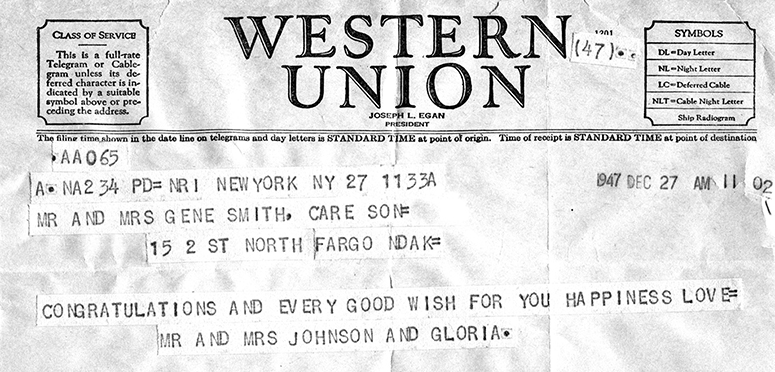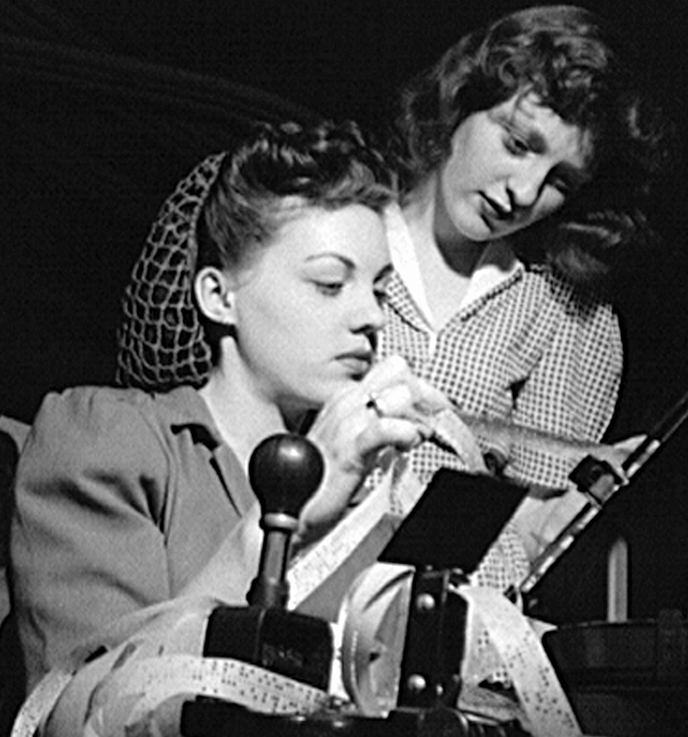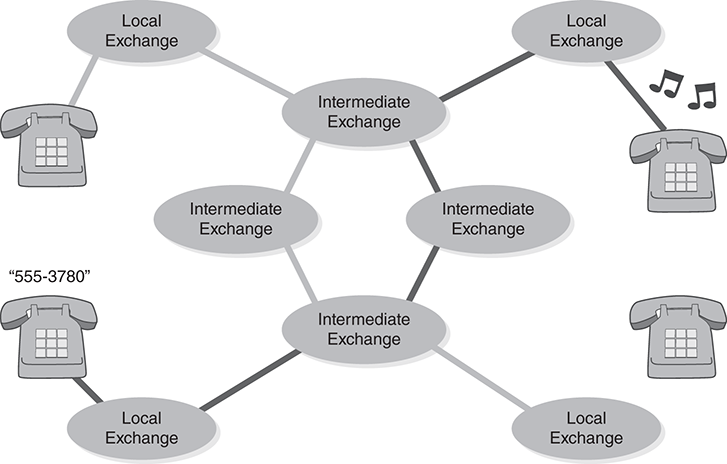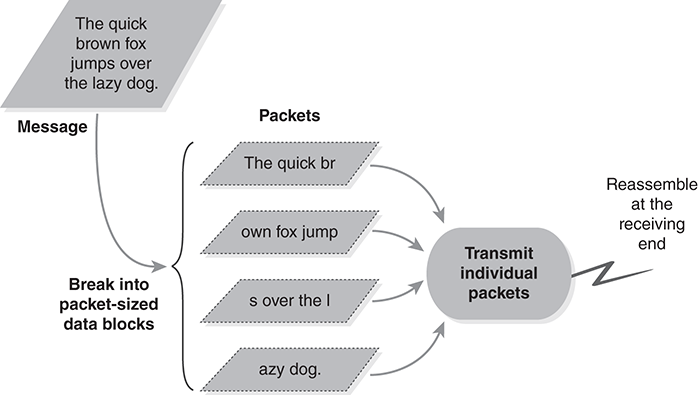▶ 10.2 Transmitting Data
Humanity has carried written messages for as long as it has had written words. Data networks eliminate the physical messages: they carry the text using a common alphabet or other set of symbols, often at the speed of light. Signal fires were perhaps the earliest such technique, though telegraphs were the first data networks to cover the globe.
The first true telegraph sent messages a letter at a time via sets of flags; the electrical telegraph coded letters as a series of clicks. The telegraph required skilled operators. To send or receive a message, the operator had to convert it between written text and telegraph code. Speed and reliability depended on operator skill, and good operators were hard to find.
This posed a particular challenge to stockbrokers and other investors. Money was made or lost by responding quickly to price fluctuations. For many years, brokers relied on runners to bring price information to their offices, and it wasn’t practical for brokers to keep a staff of telegraph operators.
In 1867, Edward Callahan produced a device to convert telegraph signals directly into printed text. This became the first “stock ticker,” which printed stock transactions onto a stream of “ticker tape.” In 1874, Frenchman Émile Baudot patented his “printing telegraph” that used a keyboard to transmit telegraph messages. A series of improvements led to electromechanical teletypes that fully automated telegraph transmission. By World War I, teletypes had replaced telegraph keys in major telegraph offices. The receiving office printed out the message and pasted it to a telegram form to deliver to the recipient (FIGURE 10.3).

FIGURE 10.3 A mid-20th century telegram from New York to Fargo.
Courtesy of Dr. Richard Smith.
While the ticker tape system broadcast the same messages to numerous recipients, most telegraph messages traveled between one sender and recipient. For example, Bob’s great uncle in New York might have needed to send a telegram to his cousin in Boston. Because the cities are a few hundred miles apart and do a lot of business with each other, there was a telegraph line (a network link) directly connecting the two cities.
To send the telegram, Bob’s great uncle wrote out the message and handed it to a telegraph clerk. The clerk collected payment, found a teletype, and connected it to the Boston link (FIGURE 10.4). The clerk typed the message in the New York office, which simultaneously typed out on a teletype in the Boston office. A clerk at that office dispatched a courier to take the telegram to the cousin’s address.

FIGURE 10.4 A clerk connects a teletype to a network link.
Library of Congress, Prints & Photographs Division, FSA/OWI Collection, LC-USW3-032342-E.
If Bob’s great uncle needed to telegraph wedding congratulations to his niece in Fargo, North Dakota, the process was more difficult. The great uncle still wrote out the message, handed it to the clerk, and paid for it.
However, the price was much higher because the message traveled farther and needed additional handling to reach its destination. At the time, Fargo was too far away and too obscure to have a direct line from New York. Instead, the telegram had to travel through a network of links that connected telegraph offices in major cities. Each office collected the message and retransmitted it down a link to take it closer to Fargo. As we can see on the telegram in Figure 10.3, it took almost a half hour to send a telegram halfway across the continent, crossing one time zone.
This example highlights a major difference between telegraph and telephone networks. A telephone conversation required a complete, end-to-end connection between both phones. The network had to establish the connection and keep it working for the duration of the call. Telegrams, on the other hand, were more like letters. The sender and recipient didn’t have to be present at the instant of transmission. The message didn’t have to traverse the network all at once; it could travel in stages.
When we combine this perspective of older networks with the capabilities of modern computer networks, we find three different strategies for sending data across a network.
Message switching—used by postal and telegraph networks.
Circuit switching—used by traditional telephone networks.
Packet switching—used by modern computer and cell phone networks.
We examine each of these here.
10.2.1 Message Switching
Postal systems and classical teletype networks use message switching. In the postal system, each letter or parcel moves as a single, indivisible unit. Each time a batch of mail is sorted, each letter is redirected to another office that brings it closer to its destination.
Moreover, the sender and recipient don’t have to arrange a specific time to send and receive individual messages. The messages may arrive and wait for delivery. In the previous section, Bob’s great uncle sent a telegram to his niece in distant Fargo. The niece did not abandon the wedding party to attend the telegram’s arrival. The message reached the office at an unpredictable time and was delivered to the new bride by messenger.
Like letters and parcels, each telegram is a single, indivisible unit. The great uncle’s telegram travels through the network as a single message. The message might traverse several offices on its trip across the country. Instead of retyping the message, the offices punched each incoming message on a stream of paper tape (FIGURE 10.5).

FIGURE 10.5 Teletype clerks check a message on paper tape.
Library of Congress, Prints & Photographs Division, FSA/OWI Collection, LC-USW3-032342-E.
Then an operator placed the punched tape in a machine connected to the message’s next destination, and the machine automatically retyped the message.
To send the great uncle’s message, the clerk in the New York office first connects a teletype to a westbound link leading to Pittsburgh or some other city closer to Fargo. The clerk types in the message and it prints out in the Pittsburgh office. From there, another clerk relays the message to another office, perhaps in Chicago, moving the message even closer to Fargo.
Electronic mail systems use the same approach. When we send an email, the system handles and delivers the message as a single unit. We never receive part of an email; the system only handles and delivers complete messages.
Message switching has the following advantages:
■ Independent receipt. Sender and recipient don’t have to arrange a specific time to exchange a message.
■ Completeness. The network delivers the entire message to the recipient or nothing at all. The network isn’t designed to handle partial messages.
Message switching has these disadvantages:
■ Size limits. Message size may be limited by equipment capacities. Longer messages are much harder to handle and are more likely to encounter errors.
■ Longer delays. Each node must collect the entire message before it can forward it to another node in the network. This prevents the network from delivering different parts of a long message in parallel, which would reduce its delivery time.
10.2.2 Circuit Switching
Telephone systems traditionally use circuit switching. This dates back to the earliest telephones. When connecting a phone call, the network establishes a specific circuit to carry that individual call from the originating phone to the destination. This is because the network must carry the analog sound signals produced by the two speakers. The sound must travel as fast as possible between the phones. Even a short delay may make it hard for the speakers to carry on a conversation.
To create a circuit for a phone call, the network assigns pieces of the network to that specific call (FIGURE 10.6). It assigns wires called trunks in each network link that connects the two phones. It also assigns circuitry inside each exchange.

FIGURE 10.6 A phone call makes a circuit between two phones.
Whenever either person speaks, the electric signal passes along the link from the phone to the local exchange. From there, it travels across a circuit to take it to the network link leading to the next exchange that carries the call. This continues until it reaches the local exchange at the other end of the call. The signal then passes along the link that connects to the call’s recipient. When either party hangs up the phone, the network reclaims the circuits and data links for use in another phone call.
The 20th century telephone system was so successful that their network engineers had trouble seeing the possible benefits of other networking strategies. Many such experts argued strongly against the use of packet-switching technology when it was new. Their connection-oriented network reliably supported a broad range of services, so their argument seemed plausible at the time.
Circuit switching provided these advantages:
■ Rapid connections. The network could quickly establish a connection between any two endpoints.
■ Low delays. Unexpected pauses can disrupt the natural flow of a conversation and discourage people from using the connection. The network needs to transmit and receive messages without unnatural delays.
■ Multiple messages. Once the endpoints were connected, they could exchange numerous messages.
Circuit switching also had these disadvantages:
■ Concurrent receipt. The sender can’t send a message until the recipient is present to receive it.
■ High overhead. The network had to set aside the resources to carry a person’s voice even while the person wasn’t actually speaking.
Today’s telecom systems still provide a circuit between two phones for the duration of the call, but the underlying systems may also rely on packet switching. Modern telecom systems use variants of SS7, a digital signalling protocol, to assign trunks to a new telephone call. The trunks themselves might be analog connections between exchanges, although modern long-distance systems use digital trunks.
Cellular phone networks use different switching technologies internally, traditionally the Global System for Mobile Communication (GSM) and code division multiple access (CDMA) standards. Like SS7, these use packet switching to manage trunk connections for cellular phone calls.
10.2.3 Packet Switching
Packets are blocks of digital data that are neither too large nor too small to handle efficiently. Each packet travels across the network independently. Small messages travel as a single packet. Larger messages are broken into pieces, and each travels in its own packet (FIGURE 10.7).

FIGURE 10.7 A packet network sends messages a packet at a time.
This is a completely different approach from either message switching or circuit switching. This strategy emerged in the 1960s as researchers imagined new ways to build self-managing computer networks.
Packet switching is similar to sending messages on postcards. We can easily send a short message, but a very long message poses a challenge. We still can send the message, but we must write part of it on each card, and then send the cards individually. Each postcard travels through the postal service (the network) separately. The recipient can start reading the message as soon as the first postcard arrives, but the message might not make sense until all postcards arrive.
From the network’s point of view, a packet needs the same basic information as a postcard:
■ The destination—required, or the network can’t deliver it.
■ Damage detection—implicit in postcards, because we see any tears, smudges, or other injuries.
■ The data to carry—optional, but a card seems pointless without it.
■ The sender—optional information; the sender writes down a claimed identity but the claim is not always trustworthy.
Every packet contains a special data area, the packet header, which contains this information. The network itself may use the header information, or it may be used by the recipient host.
Packet switching provides these advantages:
■ Resource efficiency. The network only sets aside enough resources to handle individual packets.
■ Flexible routing. Each packet may be routed individually even if all packets are going to the same destination. If network conditions change while packets are in transit, each may take the best path the network finds for that packet.
■ Parallel transmission. When we send a series of packets to the network, each packet starts on its way as soon as the network accepts it.
■ Service flexibility. We can build an efficient circuit- or message-switched service with a packet service.
Packet switching also has these disadvantages:
■ Reliability. Either the endpoint hosts or the network itself must have additional technical features to guarantee reliable and orderly transmission.
■ Variable delay. Different packets traverse the network at different rates. There is no way to control or even predict the delay encountered.
■ Concurrent receipt. The network only delivers packets to recipients who are actively accepting them. The sender may send packets without knowing if the recipient is available; if the recipient can’t or won’t accept the packets, then they are discarded.
Like postcards, it’s possible to lose packets in a computer network. Technology is never 100 percent effective, and packets can disappear into a network without a trace. Likewise, the post office won’t know which postcards, if any, disappeared.
The simplest and lowest-cost packet networks, like Ethernet, take no special steps to detect lost packets and ensure their delivery. When the network does not take steps to ensure reliable delivery, we call the packets datagrams.
Many of the earliest packet networks tried to ensure that all packets were delivered in the order they were sent. This required additional information in packet headers, and a set of rules to identify packets that were—or were not—received. This provides a protocol, a set of rules to establish effective communication.
To provide reliable packet delivery, a reliability protocol had to be incorporated either into the network or into the endpoint hosts. Experience showed that the system achieved higher reliability by placing that task in the endpoint hosts. Thus, the network itself focused on packet transmission. The endpoints kept track of packet order and verified packet delivery.
Mix-and-Match Network Switching
Different types of communication require different types of handling. Regardless of the underlying network, we often have to transmit messages, send a stream of data, or send a number of short messages to many destinations. Although message, circuit, or packet switching may seem ideal for specific types of traffic, we can in fact carry any type of traffic atop any type of switching.
The first packet-switching networks were built atop the circuit-switched telephone network using dedicated, leased network links. Today, many telephone networks rely on packet-switched backbone networks to provide circuit-oriented connections. We also use the packet-switched internet to provide reliable circuit-oriented connections between hosts and to deliver message-switched email. Researchers even have encapsulated packets in messages to provide packet switching atop message-switched systems.
